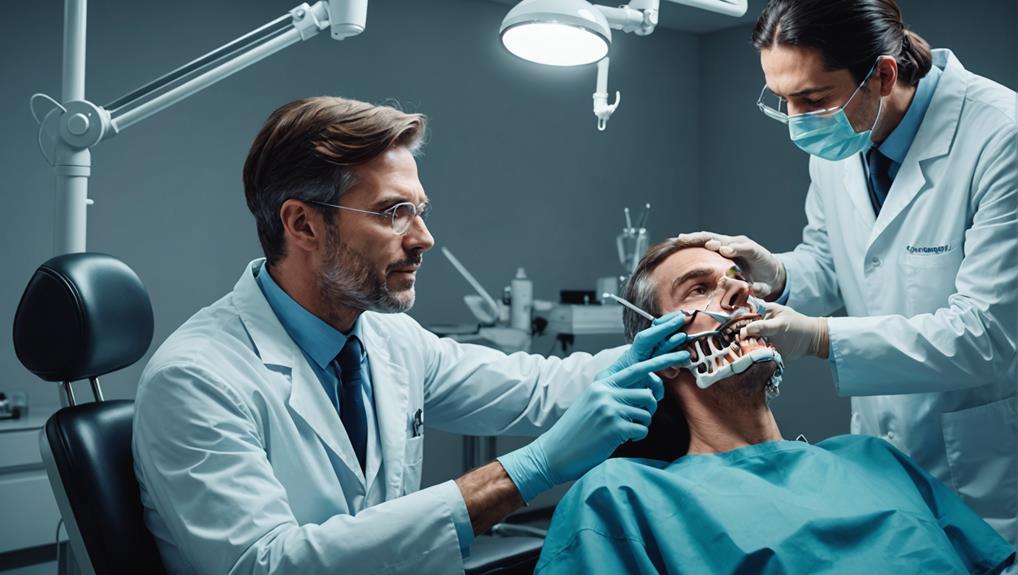Summary
Interested in the Gnathology? This is the examination of the jaws, which is fundamental in modern dentistry. Guided by the jaw mechanics, investigates how teeth align and jaws move. Balanced chewing ensures uniform chewing forces, preventing problems such as TMJ disorders. This field delves into bite force analysis, individualized treatments and digital advances. From diagnosing the malocclusions to investigating TMJ function, the importance of Gnathology in dental care is vast. Embraced by dentists, it offers innovative solutions for diverse oral health needs. Learn how jaws reveal the secrets to a healthier smile and ideal function.
Origins of Gnathology

We explore the fascinating origins of the Gnathology, beginning with its historical roots in the early 20th century. Gnathology, derived from the Greek word 'gnathos' meaning jaw, is a branch of dentistry that focuses on the function of the masticatory system and its disorders. The foundations of Gnathology can be traced back to the pioneering work of the Dr. Pierre Fauchard in the 18th century, considered the father of modern dentistry. However, it was not until the early 20th century that Gnathology began to emerge as a specialized field within dentistry.
In the 1900s, the Dr. Edward Angle, known for his significant contributions to theorthodontics, laid the foundation for Gnathology by emphasizing the importance of understanding the relationship between teeth, jaws and surrounding structures. His teachings paved the way for further advances in the study of theocclusion and of the temporomandibular joint disorders, which are central to the principles of Gnathology today. Through the dedication of early pioneers such as Dr. Angle, Gnathology has evolved into a crucial discipline that continues to shape modern dental practices.
Evolution of Gnathology
L'Evolution of Gnathology showcases the progression of this specialized branch of dentistry from its ancient roots to its current position as an essential discipline in modern dental care. Initially focused on understanding the movement and function of the jaw, gnathology has undergone significant changes over time. In the past, gnathologists were primarily concerned with problems such as the temporomandibular joint disorders and occlusal discrepancies. However, with advances in technology and research, gnathology now includes a wider range of topics such as thedigital occlusal analysis, the computerized tracking of the jawbone and the neuromuscular dentistry.
The evolution of gnathology has been driven by the increasing complexity of dental cases and the demand for more precise treatment options. By integrating principles from various dental specialties, gnathologists can now provide thorough treatments that take into account not only the teeth, but also the surrounding structures and muscles. This multidisciplinary approach has positioned gnathology as a vital field in modern dentistry, offering innovative solutions to patients with diverse dental needs.
Meaning in Dentistry

We talk about the significance of the gnathology In dentistry. Understanding thedental occlusion is essential for diagnosing and treating bite problems. Assessing bite alignment and analyzing jaw movement are vital aspects of gnathology that help improve overall oral health.
Importance of Dental Occlusion
Understand the importance of the dental occlusion is fundamental in the field of dentistry because it plays a key role in the health and general function Of the oral cavity. Dental occlusion refers to the way your teeth fit when your jaws are closed, affecting various aspects of your oral health. Proper dental occlusion ensures a Uniform distribution of chewing forces, preventing excessive stress on certain teeth that could lead to wear, fractures, or pain.
When your dental occlusion is out of balance, it can lead to problems such as bruxism (teeth grinding), temporomandibular joint (TMJ) disorders, headaches, and even difficulty chewing. In addition, poor dental occlusion can affect your pronunciation and facial aesthetics. Dentists often evaluate occlusion to diagnose and treat conditions such as malocclusion, where the teeth do not align properly.
Assessment of tooth alignment
Assessing your bite alignment is of substantial importance in dentistry, representing a key step in evaluating the health and function of your teeth and jaws. Your bite alignment, also known as occlusion, refers to how your upper and lower teeth meet when your mouth is closed. Dentists evaluate your bite alignment to identify problems such as malocclusions, in which teeth do not align properly, which can lead to problems such as uneven tooth wear, jaw pain, and difficulty chewing.
Analysis of jaw movement
Assessing jaw movement is essential in dentistry, offering valuable perspectives on the function and health of oral structures. By analyzing how your jaw moves during various activities such as chewing, speaking, and yawning, dentists can diagnose conditions such as temporomandibular joint (TMJ) disorders, malocclusions, and muscle imbalances. Understanding the movement of your jaw helps create individualized treatment plans to address problems related to bite alignment, muscle tension, and overall oral health.
To give you a clearer picture, here is a table illustrating the importance of jaw motion analysis in dentistry:
| Importance of Jaw Movement Analysis | Meaning |
|---|---|
| Diagnosis of TMJ Disorders | Identification of problems related to the function of the jaw joint. |
| Assessment of Malocclusions | Understanding of improper bite alignments. |
| Management of Muscle Imbalances | Addressing problems related to muscle coordination. |
Exploration of the mechanics of the jaw
We explore the fascinating field of jaw mechanics in gnathology. From the analysis of the clamping force to understanding the complexities of TMJ function, these points illuminate the intricate dynamics of the human jaw. Get ready to discover the secrets about how our jaws work and the vital role they play in our daily lives.
Bite Force Analysis
Investigates the intricate mechanics of jaw movement and bite force analysis in the field of gnathology. Understanding how the jaw works and the force it exerts during biting is essential in various aspects of dentistry. Bite force analysis involves measuring the pressure applied by the teeth when they come together. This analysis helps diagnose problems related to occlusion, temporomandibular joint disorders, and even in designing dental prostheses.
Researchers use specialized tools such as force sensors and pressure-measuring devices to quantify the forces generated during the bite. By studying bite force, dentists can determine whether an individual has a balanced bite or whether there are abnormalities that cause discomfort or other problems. Factors such as tooth alignment, muscle strength, and temporomandibular joint condition all play a role in the force exerted during the bite.
Through bite force analysis, dentists can tailor treatment plans to address specific problems, ensuring excellent oral health and function. This detailed examination of jaw mechanics provides valuable perspectives that help enrich dental care practices.
Functionality of TMJ
Investigating the function of the temporomandibular joint (TMJ) uncovers the intricate mechanics of jaw movement in gnathology. The TMJ acts as a hinge connecting the jawbone to the skull, facilitating essential functions such as chewing, speaking, and yawning. This joint is a complex system involving muscles, ligaments, bones, and a disc that allows smooth and coordinated movements.
When you open and close your mouth, the ATM slides and rotates to enable these actions. It works through a combination of hinge-like and sliding movements, ensuring that your jaw moves smoothly in various directions. In addition, the TMJ is responsible for maintaining the balance and stability of your jaw during functions such as biting and chewing.
Understanding TMJ function is critical to diagnosing and treating jaw disorders or discomfort. Problems with this joint can cause pain, clicking noises or restricted movement. By delving into the intricate mechanics of the TMJ, gnathologists can offer valuable perspectives on improving jaw function and overall oral health.
Understanding of the clamping function

Have you ever wondered how bite function affects your oral health and overall well-being? Your bite is not just about how your teeth meet; it plays a vital role in various aspects of your dental health. Here are four key points to help you understand the importance of your bite function:
- Alignment: The alignment of your bite affects how your teeth meet when you close your mouth. Misaligned bites can lead to problems such as bruxism (teeth grinding) and uneven tooth wear.
- Pressure Distribution: A balanced bite ensures that the pressure of chewing is evenly distributed over all your teeth, preventing excessive stress on certain areas.
- Muscle Function: Proper bite function aids in the efficient functioning of the jaw muscles, reducing the risk of muscle pain and fatigue.
- General Health: A healthy bite can positively affect your overall health, as it allows you to chew your food properly, facilitating digestion and nutrient absorption.
Understanding the function of your bite can lead to better oral health practices and overall well-being.
Clinical applications in dentistry
In the field of dentistry, clinical applications play a crucial role in the diagnosis and effective treatment of various oral health conditions. Through the use of advanced technologies and techniques, dentists can offer patients personalized treatment plans that meet their specific needs. Below is a table illustrating some common clinical applications in dentistry:
| Clinical Applications | Description |
|---|---|
| Digital Radiography | It uses digital sensors for detailed images of the teeth and surrounding structures. |
| Intraoral Cameras | Small cameras used to capture high-quality images inside the mouth. |
| Laser Dentistry | It involves the use of lasers for precise treatments such as gingival reshaping and caries removal. |
| Computer-Aided Design (CAD) | Use computer technology to design and fabricate dental restorations. |
| Oral Cancer Screening | Includes extensive examinations to detect early signs of oral cancer. |
These clinical applications improve the accuracy of diagnoses, optimize treatment outcomes, and ensure that patients receive the best possible care.
Research implications

Investigating the implications of research in gnathology can offer valuable perspectives on advances in dental treatment methods and technologies. Through research, experts can discover innovative approaches and solutions that improve the understanding and treatment of various conditions related to the temporomandibular joint and occlusion. Here are some key points to explore:
- Biomechanics Studies: Research in gnathology delves into the biomechanics of the jaw, helping to optimize treatment strategies for conditions such as bruxism and mandibular misalignments.
- Materials Science Investigations.: Investigating new materials for dentures and devices can lead to more durable and comfortable solutions for patients with gnathological problems.
- Advances in Digital Dentistry: Research in this area focuses on using cutting-edge technologies such as 3D printing and digital scanning to improve the accuracy and efficiency of dental treatments.
- Patient-Centered Outcomes Research.: Understanding how different gnathological treatments affect patients' quality of life is essential for developing personalized and effective treatment plans.
Frequently asked questions
How does Gnathology differ from traditional dentistry?
Thus, gnathology and the traditional dentistry differ in focus. While traditional dentistry deals with general oral health, gnathology specializes in the temporomandibular joint (TMJ) and how it affects your occlusion and jaw movement. Focusing on the entire masticatory system, gnathologists can more accurately diagnose and treat problems related to jaw alignment and function. This specialized approach distinguishes gnathology from traditional dental practices.
Can Gnathology help with chronic jaw pain?
Yes, gnathology can be beneficial to the chronic jaw pain. Focusing on the relationship between the jaw joints, muscles and teeth, the gnathologists can diagnose and treat problems that may be causing your discomfort. Through techniques such as occlusal adjustments and customized oral devices, they aim to relieve pain and improve jaw function. Consulting a gnathologist could provide you with specialized care aimed at addressing your specific concerns about jaw pain.
Are there any risks associated with gnathology treatments?
When considering gnathology treatments, it is important to be aware of the potential risks. Although generally safe, some procedures may involve minimal risks such as temporary annoyances or swelling. It is critical to consult a qualified specialist who can assess your individual situation and discuss any complications. Staying informed and following the instructions for the post-treatment care, it is possible to minimize the risks associated with gnathology treatments.
What advances are being made in gnathology technology?
Advances in gnathology technology are improving treatment outcomes. New imaging techniques, such as 3D scanning, provide detailed views of the jaw and bite. Computer-aided design allows precise customization of dental appliances. Robotics are also being explored to improve surgical procedures. These innovations help dentists diagnose problems more accurately and offer more effective solutions. Keep abreast of these developments to ensure you receive the best possible care for your jaw health.
Can Gnathology be used to improve facial aesthetics?
Yes, the gnathology can actually be used to improve thefacial aesthetics. By understanding the intricate relationship between the jaw, teeth and facial muscles, specialists can develop treatment plans that not only improve oral function but also contribute to a harmonious facial appearance. Through advanced technologies and techniques in gnathology, a more balanced and aesthetically pleasing facial structure can be achieved while ensuring maximum oral health and function.
